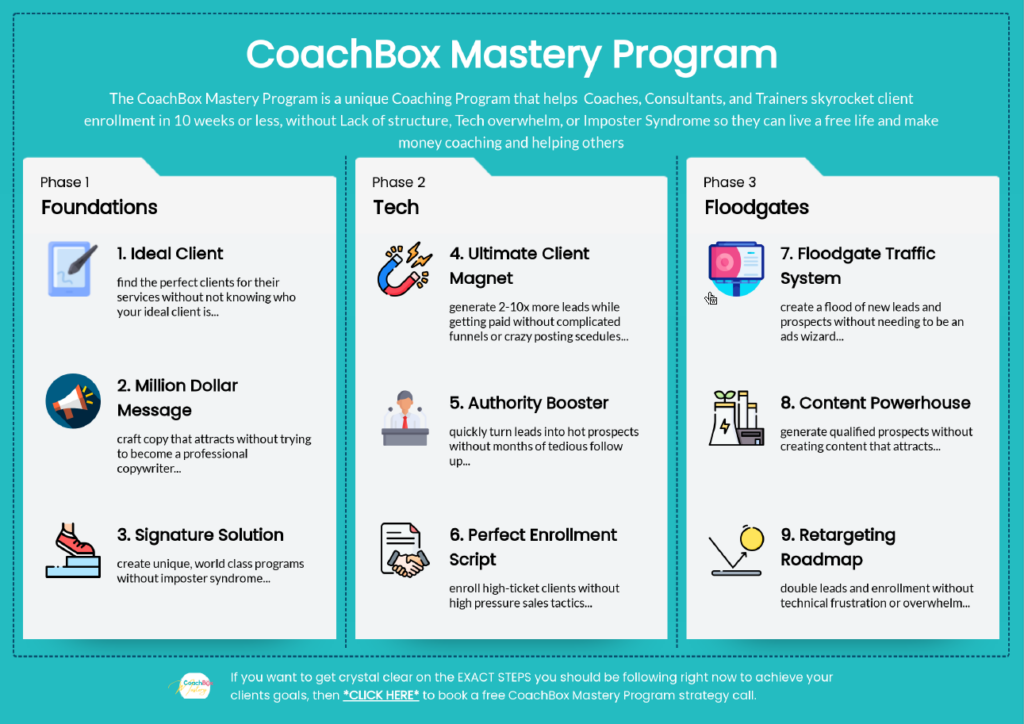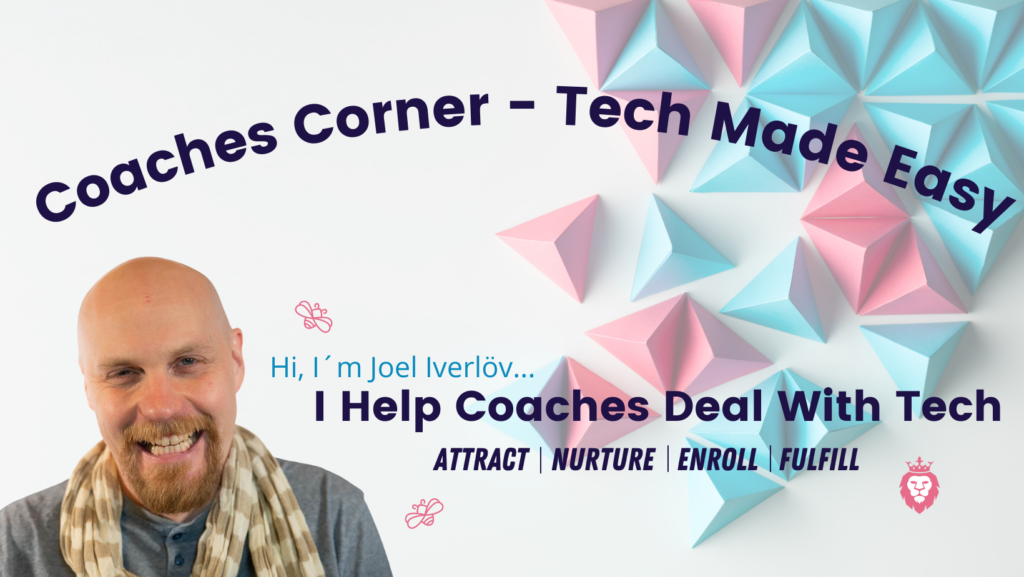Introduction
Coaching is one of the fastest-growing industries in the world. And it’s not hard to see why: coaching helps people change their lives for the better and has a positive impact on our communities and society at large.
However, if you’re just getting started with your own coaching business, it can be intimidating to know where to start. In this article, we’ll cover how to create a profitable and impactful coaching program in seven easy steps!
One of the biggest mistakes we see coaches make is not having a flagship, signature coaching program where they can consistently attract coaching clients and create powerful coaching sessions! So what better time than now to get you started and set up with one?
Are you ready to jump in?
Step 1: It all starts with your Ideal Client!
First, we need to dive deep into the mind of your ideal client! Make sure you have just ONE person in mind and do the research based on her. Don’t be broad, be specific and precise!
Write down a list of all your client’s problems, desires, and concerns. Go deep, and really make sure to understand how they think, what they desire, what scares them, and what their biggest issues or problems are!
This is the most important step because it will help you create an impactful coaching program that is simple, profitable, and easy to deliver.

If you don’t know what they want or don’t know why they’re looking for a coach then how can you provide value to them?
Here are some questions to ask yourself:
- What needs does your client have?
- How many people are looking for a solution to what you solve?
- Is the market growing?
- How can you solve the client’s need better, faster, or cheaper?
- Can your client afford your solution?
- How big is the niche?
- Can you find a solution that is subscription-based?
- How can you become the “Go-To Provider” in your niche?
- How competitive is the niche?
- How do your competitors communicate with potential clients?
- How easy is it for you to find potential clients in this niche?
- What social media channels are dominating this niche?
- What experts, books, blogs, podcasts, or other channels does your ideal client frequently read or listen to?
Step 2: Choose ONE problem you solve!
Next up is defining that ONE problem your ideal client is most keen on getting fixed! By now you should know that based on the work you did in step one.
Keep in mind that you will be solving multiple issues along the way but one is the main one. And we will build the entire program around that!
Many coaches try to tackle multiple problems, but it’s far better to pick the one that resonates with your clients and where you can make a big impact. Choose the problem that you care about solving and are passionate about. If you don’t care, neither will your clients.
The best way to find this is by asking yourself questions like:
- What am I best at solving?
- What experiences do I have that could help someone out?
- What do I love doing that could help someone else out?
- What do I know about that would be useful for other people?
- What are the problems I see my friends and family facing, and what could I do to help them out?
These are some great questions because they help you to narrow down your focus and get clear on what your clients need, and what you enjoy doing!
Join Us on Facebook and get access to more great free content!
Step 3: Select the Outcome
Once you’ve defined the problem, it’s time to decide the outcome you create for your clients.
You should be able to see how your program will solve this problem and meet this need in the lives of your clients. But before committing to that, stop and consider.
What is the outcome you want to create? What does that look like? What would be a great result for your clients and their lives?
The difference with this approach is that we don’t sell time, nor do we sell sessions. We deliver a specific outcome that our ideal client wants the most! This makes your program unique and infinitely more powerful. Because by the end of the day – no one wants to buy time – they want to buy a solution. This is why you need to focus on the outcome, not the time or sessions. The outcome is what your ideal client wants most and it’s what they will happily pay you for!
Step 4: Reverse-Engineer the program
Once you have a clear understanding of the outcome, it’s time to reverse-engineer the program. In other words, take a look at what the end result for your client will be and see how it can be broken down into smaller pieces that are more manageable. Then, build those pieces one at a time.
Ask yourself, what needs to happen for the client to have the outcome they desire? And then start from the outcome and go back to where they are now.
- You know exactly where you are going. This creates structure and will help you feel secure when delivering your program. Reverse engineering requires that you think about where you want to take your clients before trying to figure out how to get there. This helps keep you focused on the outcome without getting distracted by unnecessary tasks along the way or missing key steps between points A and B (or C).
- It keeps things simple because it breaks down complex tasks into easier ones so that they don’t seem overwhelming or impossible anymore—which is especially important when creating an online coaching program! When we reverse-engineer your outcome we will find “checkpoints” along the way that lets us know we are on track. This is the most important part of creating an online coaching program because it will keep you from getting lost in the weeds and help you stay focused on your end goal.
- It also helps ensure that you are not forgetting any steps along the way. By knowing where you are in the process and what your next steps are, you can feel confident that you are moving forward and not spinning your wheels.
Step 5: Create a process to take your clients through
Now that you know what problem you’re solving and what result you want to create for your clients, it’s time to get specific about how this will happen! The solution can be as simple as a single action step or a series of steps. We usually use nine steps when we create programs.
One of the most crucial parts of this step is creating a detailed walkthrough of your program. In the previous step, we reverse-engineered the sets your clients need to take to get from point A to point B. Now it’s time to turn it into a process.

The process should be easy to follow, with all steps clearly explained so that it doesn’t leave any room for confusion. The more clear and concise you make it, the better results it will yield!
Your goal is to make your program as easy to follow as possible so that people can see what results they can expect. We’ve found that the best way to do this is by creating a step-by-step process that shows all of the steps your client will take (including what they should think or feel while doing them).
I recommend you focus on the transformation in each step, as that is what it ultimately is all about. The more you focus on the transformation, the easier it will be for your client to see how their life can change. You want them to start thinking about what they want and how they can achieve it.
Here's an example of our flagship program "CoachBox Mastery".

Step 6: Launch & implement, and learn!
The launch of your Coaching program is just the beginning. You must be learning from each launch, implementing changes as you go, and repeating the process.
The fact of the matter is that before you have had 5-10 clients go through your program, you don’t really know if it’s working as well as you thought or not. That is why we need to launch, and then constantly improve! Don’t strive for perfection, find the MVP – Minimum Viable Process and start serving people!
Get feedback, and improve! The point of launching and implementing is to get feedback on how well your Coaching program actually works. You will learn more from this than any amount of research or testing beforehand could have told you. As you go through this process, try to identify what people love about it, what they don’t love so much, and what they need more help with. Then create new content or change things in the program based on that feedback.
Repeat the process!
Why? Because repetition is key to success. It doesn’t matter what industry you’re in or what service you offer—if people can do it once they can do it again (and again). But what makes this even more important than just being able to repeat yourself over time is that every time you repeat yourself, things get easier because there are fewer unknowns on each subsequent run-through.
For example, if you’re a fitness coach and your client doesn’t love the way their abs look once they start working out with you, then create new exercises or change things up in their program so that the outcome is better for them. If it’s still not perfect, then try again until it is.
Step 7: Price and timeframe?
Once you have your program mapped out and done, let’s think about how long it needs to be. Since we are 100% outcome focused we don’t really care for generic timeframes…
Instead, ask yourself, how much time do I need to be able to deliver the desired and promised outcome? That will be your timeframe.
When it comes to pricing I will challenge the “traditional” ideas and beg you to consider a different price model. Instead of time or sessions, price your program based on the outcome. Meaning if you solve a big enough problem, people are willing to pay a higher price.

Our clients routinely charge between $3 500 – $15 000 for their coaching programs, and you are just as likely to do the same. You will however need to consider how your business and program are structured to be able to do that. You will need to have a clear and defined outcome for your program. This is key because if you don’t have one, it will be hard for someone else to buy into it.
Creating a coaching program is easier than you think!
Creating a profitable coaching program is easier than you think!
By following these seven simple steps, your coaching program can be up and running in no time.
Keep it simple. You don’t need to overcomplicate things or try to be everything to everyone. Instead, focus on the essentials of what makes a good coaching program: relevance and quality content delivered consistently and with a heavy focus on outcomes rather than sessions. That’s what people love! (and tell their friends about).
We hope these tips give you the confidence to take on your own coaching program. It’s not as difficult as it might seem, and with a little planning and forethought, you’ll be well on your way to having more clients than you can handle in no time.
I have previously written a post similar to this one, which also could help you out. You can read it here!
But we wont send you off without a final opportunity. Because we know this task sometimes feels daunting – we have opened up a few slots in our calendar for you to be able to book a free call and let one of our coaches help you structure your business!
Please note that this is not a sales call, but a possibility for you to get some great input and support to move forward faster!
If you wish to book, HERE´S the link!
All the best!
Joel and the CoachBox Team


